Notes: Rednal & West Felton was located on the Shrewsbury & Chester Railway (S&CR) which opened throughout on 14 October 1848. The S&CR was formed in July 1846 out of a merger of the North Wales Mineral Railway (NWMR) and the Shrewsbury, Oswestry & Chester Junction Railway (SO&CJR). The NWMR had started the construction of a line between Saltney Junction (near Chester) and Ruabon via Wrexham in 1844. The SO&CJR was set up to create a route between Shrewsbury and Chester and the merger enabled that task to be carried out through an extension of the NWMR line. The first section of the line opened between Saltney Junction and a temporary railhead at Rhosymedre on 4 November 1846.
The station opened as Rednal when the line was completed on 14 October 1848. It was located 13 miles to the north of Shrewsbury and a mile south-west of the small settlement of Rednal.
The main facilities were located on the down platform (Chester direction). The station building was a self-assured, two-storey Tudoresque building of red brick with stone quoins and window architraves. Facing the platform was a prominent gable with raking parapets accompanied by a dormer with its own pitched gable; each gable was crowned with a spiked finial. Lofty grouped chimneystacks rose above the slate roof, aligned at 45deg to the pitch. The up platform (Shrewsbury direction) was provided with a simple waiting shelter.
.gif) Rednal was provided with goods facilities west of the passenger station on the down side of the line; they included a large timber goods shed set back from the main line. Rednal was provided with goods facilities west of the passenger station on the down side of the line; they included a large timber goods shed set back from the main line.
To the west of the station the line passed over the Montgomery Canal which had opened in 1797. There was a canal basin on the north side of the railway served by a siding that diverged from the main line at Rednal Junction. In the early years passengers could change between rail and canal services.
The March 1850 timetable showed five up and six down trains Monday-to-Saturday. There were two trains in each direction on Sundays.
On 1 September 1854 the S&CR was taken over by the Great Western Railway (GWR). The GWR also took over the Shrewsbury & Birmingham Railway and in so doing created a route between the Midlands and the River Mersey in direct competition with the London & North Western Railway (To read more about the S&C and the GWR take over click here).
Under the GWR the line through Rossett became a busy trunk railway that carried express and local passenger trains and large volumes of freight. A Birmingham – Birkenhead express service was introduced on 1 May 1857 and a London Paddington – Birkenhead service on 1 October 1861. These were prestigious trains that called only at principal stations.
In the early 1860s the Rednal Bone Works opened adjacent to the canal basin. Animal carcasses were brought to the works by canal but the siding that had served the basin remained in situ.
.gif) On 7 June 1865 there was an accident at the Rednal Junction. An excursion train from Birkenhead en route to London came off the line at the junction killing twelve people (with more dying from injuries in the following weeks). Platelayers were working on the up line to the west of the junction. The track was not in a fit state to allow fast running. The only form of warning to drivers was a green flag on a pole. The train which consisted of two engines, 32 passenger coaches and two brake vans approached Rednal at speed at about 1.55pm. The driver of the leading locomotive did not appear to notice the green flag. The driver of the second engine did notice the flag and he applied the brakes and whistled to the driver of the leading engine. The leading locomotive then passed over a section of track that had not been correctly packed with ballast and its leading wheels came off. The engine remained upright and continued along the line until it reached Rednal Junction where the wheels hit the check rails of the points. The first engine then fell over to its left clearing the line but its tender remained on the line forming an obstruction to the second engine which was thrown to the right onto the down line. The coaches were then dashed into the tender by their own momentum which completely destroyed the first four; 11 other coaches were badly damaged. An accident report submitted to the Board of Trade on 17 June 1865 placed the blame on the platelayers and condemned the method of warning, the green flag on a pole, which had been employed. On 7 June 1865 there was an accident at the Rednal Junction. An excursion train from Birkenhead en route to London came off the line at the junction killing twelve people (with more dying from injuries in the following weeks). Platelayers were working on the up line to the west of the junction. The track was not in a fit state to allow fast running. The only form of warning to drivers was a green flag on a pole. The train which consisted of two engines, 32 passenger coaches and two brake vans approached Rednal at speed at about 1.55pm. The driver of the leading locomotive did not appear to notice the green flag. The driver of the second engine did notice the flag and he applied the brakes and whistled to the driver of the leading engine. The leading locomotive then passed over a section of track that had not been correctly packed with ballast and its leading wheels came off. The engine remained upright and continued along the line until it reached Rednal Junction where the wheels hit the check rails of the points. The first engine then fell over to its left clearing the line but its tender remained on the line forming an obstruction to the second engine which was thrown to the right onto the down line. The coaches were then dashed into the tender by their own momentum which completely destroyed the first four; 11 other coaches were badly damaged. An accident report submitted to the Board of Trade on 17 June 1865 placed the blame on the platelayers and condemned the method of warning, the green flag on a pole, which had been employed.
By the 1870s the siding and Rednal Junction had been removed.
The December 1895 timetable showed five trains in each direction Monday-to-Saturday. There were two trains each way on Sundays. There was an aditional train in each direction on the first Monday of every month.
.gif) In 1903 9.990 tickets were sold at Rednal and 8,460 parcels were forwarded. The goods yard forwarded 1,229 tons of general goods and received 1,138 tons. In 1903 9.990 tickets were sold at Rednal and 8,460 parcels were forwarded. The goods yard forwarded 1,229 tons of general goods and received 1,138 tons.
By this time the station had been provided with a signal box. It was located just west of the down platform.
Additional sidings had also been added. The 1904 Railway Clearing House Handbook of Stations listed Rednal as having a 3-ton lifting crane and facilities for handling livestock.
On 16 October 1907 the station was renamed Rednal & West Felton.
By July 1922 the station had four up and five down services on Monday-to-Saturday as shown in the table below. There were two trains in each direction on Sunday.
Up Trains July 1922 |
Destination |
Down Trains July 1922 |
Destination |
8.55am |
Shrewsbury |
8.14am |
Chester General |
12.47pm |
Shrewsbury |
11.53am |
Wrexham General |
3.35pm |
Shrewsbury |
3.29pm |
Wrexham General |
7.28pm |
Birmingham Snow Hill |
5.28pm |
Wrexham General |
|
|
7.09pm |
Chester General |
The following year 7,049 tickets were sold and 5,169 parcels were handled.
By 1933 there had been a decline in the station’s fortunes. Only 2,855 tickets were sold and 1,773 parcels were handled. The goods yard forwarded only 624 tons of general goods but it did receive 2,163 tons which was nearly twice as much as 1903. At this time the station had eight employees.
The outbreak of the Second World War on 3 September 1939 brought additional traffic to Rednal & Felton when the RAF opened an airfield in 1942. The RAF chose a site east of the station because of the flat terrain and its proximity to the railway. The purpose of the airfield was built to train fighter pilots, and although it did not have a front line combat role it was provided with defensive gun positions. RAF personnel, supplies and equipment all passed through Rednal & West Felton station during the war years which was probably its the busiest-ever period.
During the war years two women of the WAAF were killed by a train at Rednal & West Felton while crossing the line; as a result an underpass was constructed close to the station.
After June 1945 the airfield became a care and maintenance depot which would have still provided traffic for the railway but much less than in the war years.
.gif) On 1 January 1948 Rednal & West Felton became part of British Railways [Western Region] (BR[WR]). On 1 January 1948 Rednal & West Felton became part of British Railways [Western Region] (BR[WR]).
The summer timetable for 1949 showed little change with five trains each way Monday-to-Saturday. On Sunday there were still two trains in each direction.
The 1957 Handbook of Stations showed Rednal & West Felton as being able to handle horseboxes, livestock, parcels, carriages and motor cars.
The BR[WR] timetable of 15 September 1958 showed only two up and one down train calling at Rednal & West Felton Monday-to-Saturday. There was an extra up train on Saturdays and no trains on Sundays.
BR[WR] withdrew passenger services from Rednal & West Felton on 12 September 1960.
From 1 January 1963 Rednal & West Felton came under the operational control of British Railways [London Midland Region] (BR[LMR]) and was transferred fully to this region on xx July 1963. BR[LMR] closed the station to goods services on 7 October 1963.
The up platform was demolished after closure but the station building and the goods shed survived. The signal box closed shortly after the station and its base was later converted into a shed. For many years the station building was in use as a private residence but it appeared to be undergoing restoration when visited in November 2015.
In December 2023 the station building was for sale by auction with a guide price of £125,000. Following the death of the owner the building remained empty of a number of years and has been badly damaged internally. Windows are now boarded up awaiting sale.
Tickets from Michael Stewart and route map by Alan Young
Sources:
- A Regional History of the Railways of Great Britain - Volume II North & Mid Wales - Peter E Baughan - David & Charles 1980.
- Encyclopaedia of British Railway Companies - Christopher Awdry - Guild Publishing 1990.
- Paddington to the Mersey - Dr R. Preston Hendry & R. Powell Hendry - Oxford Publishing Company 1992.
- Railway Passenger Stations in Great Britain - A Chronology - Michael Quick - Railway & Canal Historical Society 2009.
- Shrewsbury to Chester - Vic Mitchell & Keith Smith - Middleton Press 2010.
To see the
other stations on the Shrewsbury - Chester General line
click on the station name: Shrewsbury S&C, Leaton, Oldwoods Halt, Baschurch,
Stanwardine Halt, Haughton Halt, Whittington Low Level, Weston Rhyn, Trehowell Halt, Llangollen Road, Whitehurst Halt, Rhosymedre, Cefn, Rhosymedre Halt, Rhos, Wynnville Halt, Johnstown & Hafod, Rhosrobin Halt, Gresford, Rossett, Pulford, Balderton and Saltney |

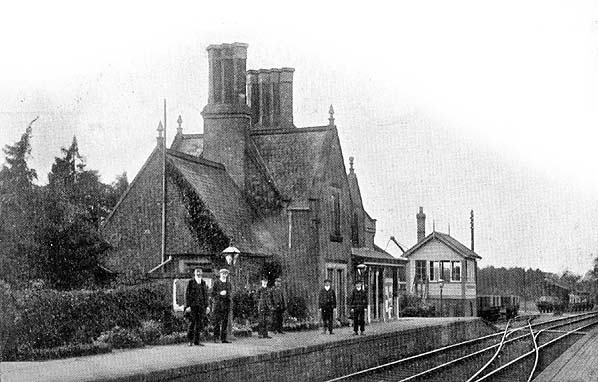
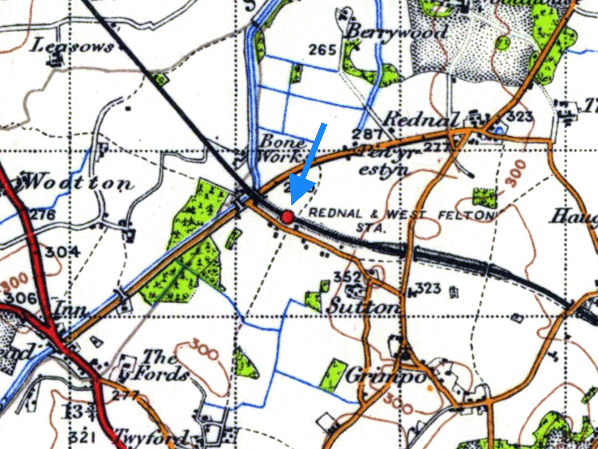
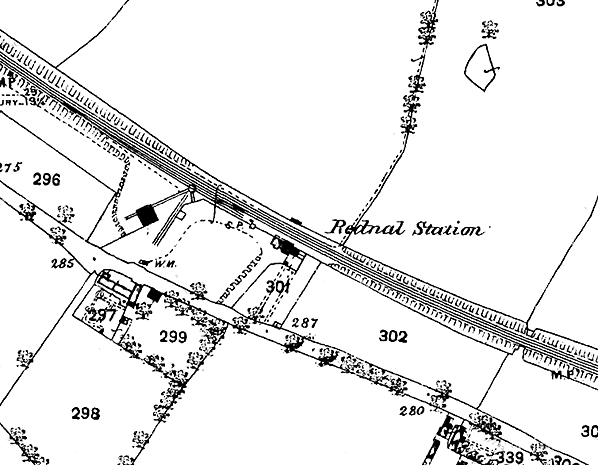
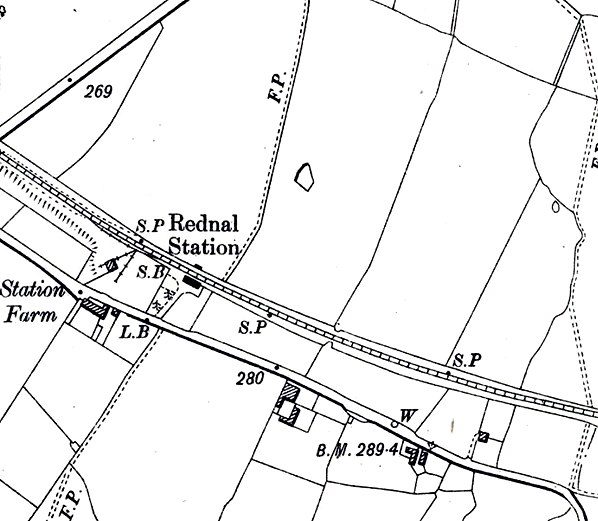
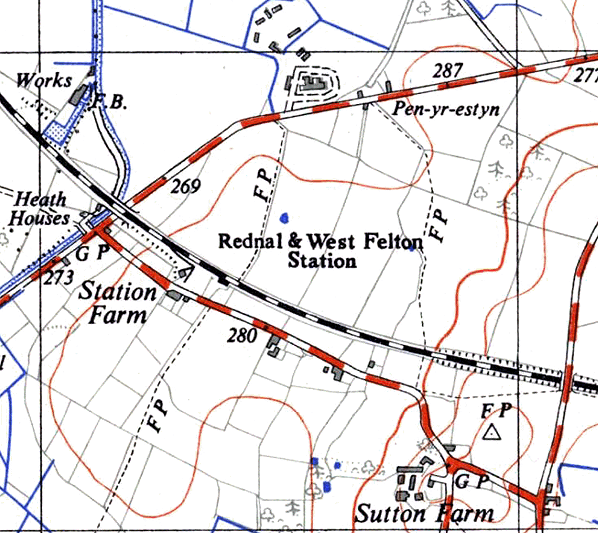
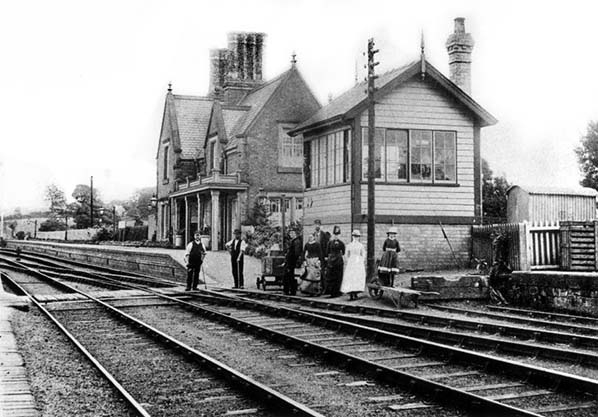
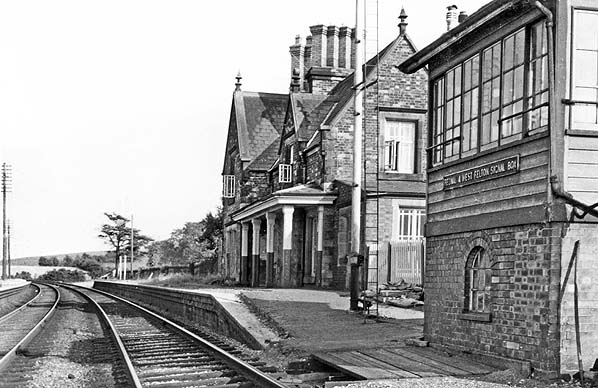
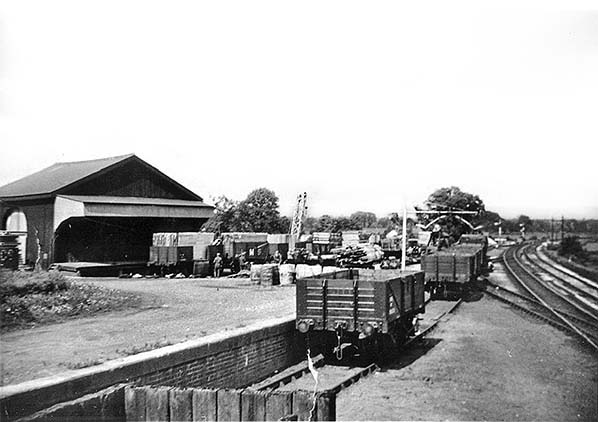
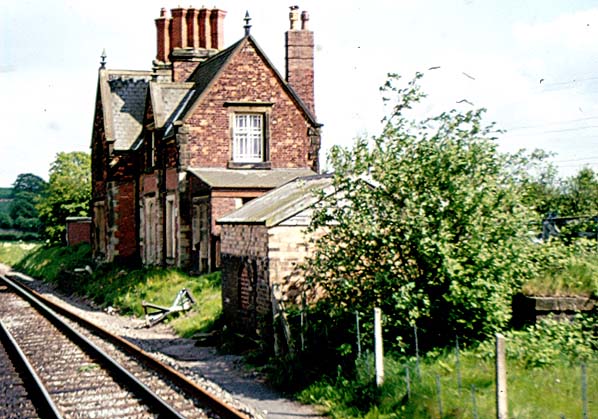
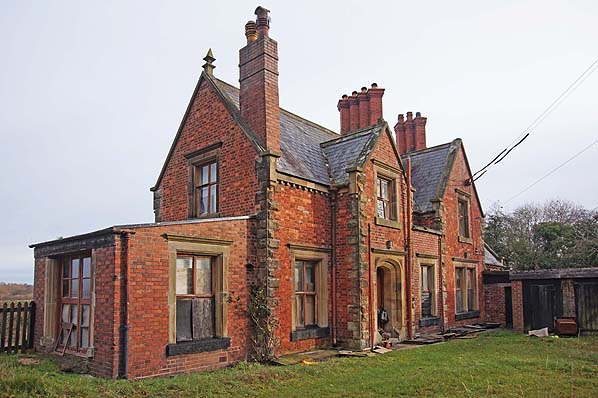
.jpg)
.jpg)
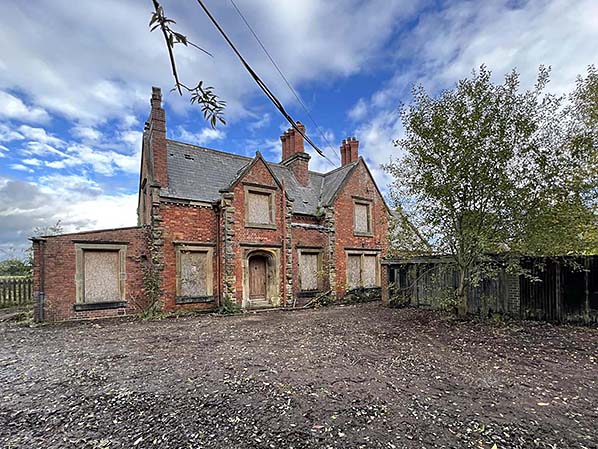
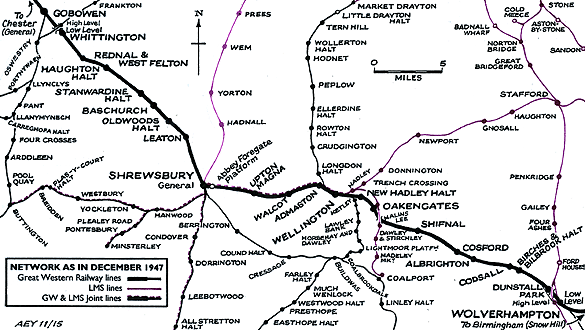
.gif) Rednal was provided with goods facilities west of the passenger station on the down side of the line; they included a large timber goods shed set back from the main line.
Rednal was provided with goods facilities west of the passenger station on the down side of the line; they included a large timber goods shed set back from the main line. .gif) On 7 June 1865 there was an accident at the Rednal Junction. An excursion train from Birkenhead en route to London came off the line at the junction killing twelve people (with more dying from injuries in the following weeks). Platelayers were working on the up line to the west of the junction. The track was not in a fit state to allow fast running. The only form of warning to drivers was a green flag on a pole. The train which consisted of two engines, 32 passenger coaches and two brake vans approached Rednal at speed at about 1.55pm. The driver of the leading locomotive did not appear to notice the green flag. The driver of the second engine did notice the flag and he applied the brakes and whistled to the driver of the leading engine. The leading locomotive then passed over a section of track that had not been correctly packed with ballast and its leading wheels came off. The engine remained upright and continued along the line until it reached Rednal Junction where the wheels hit the check rails of the points. The first engine then fell over to its left clearing the line but its tender remained on the line forming an obstruction to the second engine which was thrown to the right onto the down line. The coaches were then dashed into the tender by their own momentum which completely destroyed the first four; 11 other coaches were badly damaged. An accident report submitted to the Board of Trade on 17 June 1865 placed the blame on the platelayers and condemned the method of warning, the green flag on a pole, which had been employed.
On 7 June 1865 there was an accident at the Rednal Junction. An excursion train from Birkenhead en route to London came off the line at the junction killing twelve people (with more dying from injuries in the following weeks). Platelayers were working on the up line to the west of the junction. The track was not in a fit state to allow fast running. The only form of warning to drivers was a green flag on a pole. The train which consisted of two engines, 32 passenger coaches and two brake vans approached Rednal at speed at about 1.55pm. The driver of the leading locomotive did not appear to notice the green flag. The driver of the second engine did notice the flag and he applied the brakes and whistled to the driver of the leading engine. The leading locomotive then passed over a section of track that had not been correctly packed with ballast and its leading wheels came off. The engine remained upright and continued along the line until it reached Rednal Junction where the wheels hit the check rails of the points. The first engine then fell over to its left clearing the line but its tender remained on the line forming an obstruction to the second engine which was thrown to the right onto the down line. The coaches were then dashed into the tender by their own momentum which completely destroyed the first four; 11 other coaches were badly damaged. An accident report submitted to the Board of Trade on 17 June 1865 placed the blame on the platelayers and condemned the method of warning, the green flag on a pole, which had been employed..gif) In 1903 9.990 tickets were sold at Rednal and 8,460 parcels were forwarded. The goods yard forwarded 1,229 tons of general goods and received 1,138 tons.
In 1903 9.990 tickets were sold at Rednal and 8,460 parcels were forwarded. The goods yard forwarded 1,229 tons of general goods and received 1,138 tons. .gif) On 1 January 1948 Rednal & West Felton became part of British Railways [Western Region] (BR[WR]).
On 1 January 1948 Rednal & West Felton became part of British Railways [Western Region] (BR[WR]). 
 Home Page
Home Page